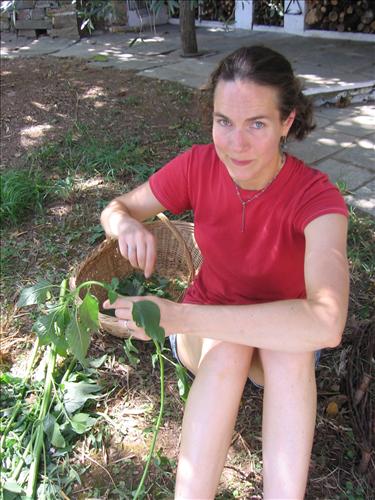Cassoeula
Well, here it is: the pig ear recipe I promised! You can't wait, can you... Well first I'm going to give you a little background info. Gabriel and I ate this last night at a friend's house and it was delicious! Not kidding, really good! The recipe here is a combination of tradition handed down from Milanese grandparent to Milanese grandchild and info from the web. Tradition and technology! Our hosts, Paola and Marco are the only two indigenous Milanese I know. Milan is like New York City - a place full of people from everywhere else. Most Italians I know here have moved here themselves for work or have parents who did. Not these guys, their grandparents are steeped in these culinary traditions, so Paola and Marco have been eating this dish since they were kids. In fact, Pietro and Pookie (Alberto), Marco's 7 and 10 year old kids sat at the table with us and devoured pig feet and tail. I couldn't get over it! At the age of 10, I would have refused to be in the room with somebody eating a pig tail. Not that it ever happened, mind you.
From what Paola and Marco printed for me, and the explanation I got last night, I can give you a pretty good idea of how this dish goes:
CASSOEULA
2 lbs pork ribs
1 lb pig trotters (that's "feet" for you non culinary types)
6 ozs of pork skin cut into 1 in squares (raw, not the fried George Bush I kind)
8 ozs of Monza sausage (any mild, medium grind pork sausage would do)
1 tbso butter
1/2 cup white wine
2 medium onions
4 carrots
3 ribs of celery
3 lbs savoy cabbage washed and roughly chopped
4 cups meat stock
salt to taste
*Optional: pig tail, pig ear
Boil the trotters, optional tail and ear, and skin for 1 hour and drain. Meanwhile mince the onion, carrot and celery very finely, almost into a paste with a food processor or a "mezzaluna" knife. Place the vegetable mixture (called a "battuto") into a very large oven-proof pot with the butter. Sautee battuto until the liquid has evaporated and the mixture starts to turn golden. Add the wine and the ribs and cook covered for 1 hour. Add stock to keep the mixture moist. After 1 hour, add the sausage, the boiled, drained trotters and skin and the cabbage. Add stock just to cover the meat and vegetables. Bring to a simmer and cook for 30 minutes more. Periodically skim the fat that rises to the surface to keep the broth clear.
Polenta is often suggested as an accompaniment for this dish but last night we soaked up the delicious golden broth with Simone and Valeria's home made sour dough bread. It was wonderful! I tasted the skin and trotter and was pleasantly surprised by their smooth, soft texture. Simone assured everybody that the skin was mainly collagen, that is, protein and not fat.
*A note on "alternative" meat: It seems like much of post WWII America has been prosperous enough (and maybe foolish enough) to "live high on the hog" and eschew all those "other" parts of the pig. As a kid, I think I tried liver once, hated it and was never presented with such a thing again. I know my grandparents ate organ meats and other cheaper parts as a way to make ends meet. Here in Italy as well as in Spain and even Switzerland organ meats are not so ostracized. I can attest to hese countries having lived there but I know that most of the world accepts this type of food. Also in African-American communities all over the U.S. these foods are prized. So if you'd like to try the trotter, ear, tail and skin or chitterlings, for that matter go to an African-American meat store like Moo and Oink in Chicago or many immigrant neighborhoods. In Minneapolis, Gabriel used to find veal tongue in a Mexican butcher shop on Nicollet Avenue.


1 Comments:
Hi Poetisa,
Back in my hometown, Chicago I grocery shopped a lot at Caputo's for Italian import stuff. The biggest difference I notice between that and the products here in Milan is the color of the packaging. You almost never find red white and green Italian flag packaging here. Makes sense. How much red white and blue packaging do we really have at home? But to answer your question, I'll list some brands. For pasta, the most well known brands are De Cecco (the most expensive here but HALF the price of what they sell it for at Caputo's!) and Barilla. Now Gabriel tells me that there are Barilla plants in the U.S. so the product may not be the same. For canned tomatoes and beans, Cirio is a well known brand here. I don't remember if that brand can be found in the States. I'd say that for packaged things, anything that's from Italy and NOT red white and green is the real deal.
Post a Comment
<< Home